Blueberries were one of the first fruits in our foodforest. They’re one of the reasons I became totally addicted to growing our own food! We started with one plant and they quickly exploded to 7 plants. Nothing beats harvesting your own fresh blueberries from your backyard – the taste, nutrition and fun eating straight off the bush. They’re ideal for backyards and read on to learn how to grow blueberries the easy way.
Why should you grow your own blueberries?

In case you need any convincing to grow these delicious berries, here are my top reasons to grow your own blueberries:
- Blueberries are small compact plants that don’t take up much space. In fact, they grow happily in a medium to large pot and look incredible on a deck or patio.
- They are originally lower canopy plants in a forest so thrive in part-shade – making them ideal for a suburban backyard. They are a real feature in a large pot on your balcony or courtyard.
- Certain varieties are quite ornamental, and their leaves turn a dramatic shade of red, pink orange and peach in autumn. They are as pretty as any ornamental plant.
- Did you know berries are one of the most heavily sprayed fruits in the supermarket? Not to mention they are expensive and come in tiny punnets with lots of packaging. Organic berries in particular cost an arm and a leg! Why buy them when you can grow your own pesticide-free berries!
- A well-looked after blueberry plant can be very productive and reward you with many kilos of fruit each season (up to 9 kg!). They are easier to grow than you think.
- Blueberries are often touted as a “superfood” – packed with antioxidants and phytoflavinoids, and are high in potassium and Vitamin C.

Wait what? You can grow your own blueberries?!
Yes you heard right! Blueberries might sound exotic, but they are actually very simple to grow in a backyard provided you follow my golden rules below.
Golden Rule 1: Blueberries must be grown in acidic soil
If you remember back to high school chemistry, pH neutral is 7. Blueberries enjoy quite a low pH of between 4.5-6 pH. This is acidic, while anything above pH 7 is considered basic. Some varieties of blueberries are more demanding about their soil pH than others. For example, our Blue Rose variety enjoys a pH around 4.5-5 while Sunshine Blue is more tolerant of higher pHs and can thrive even around 6.
- Option 1: Easy option. The easiest way to achieve the right low pH is to start with a good quality potting mix for acidic plants. The only brand I know that makes a low pH formula is Scott’s Osmocote Roses, Azalea & Gardenia potting mix. You might be wondering why we’re growing blueberries in a potting mix for flowers? Well just like blueberries, all these flowers are also lovers of acid soil! This potting mix is marketed to be in the range of 4.8-5.8 pH, which is just the sweet zone for blueberries. Check out our video workshop (above) for a pH test of this potting mix and see if it matches up to its claims. This is a no-brainer mix and has everything you need to grow happy blueberries. We have been using this mix for the past decade with our blueberries with great success and bumper harvests.

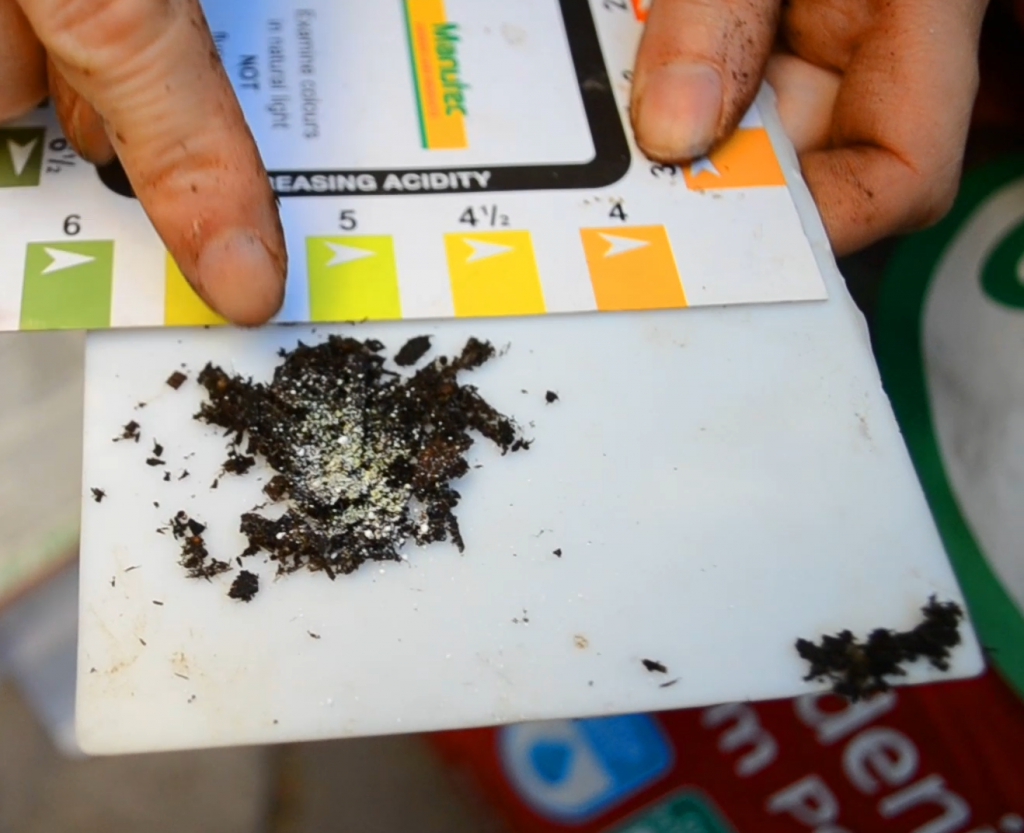
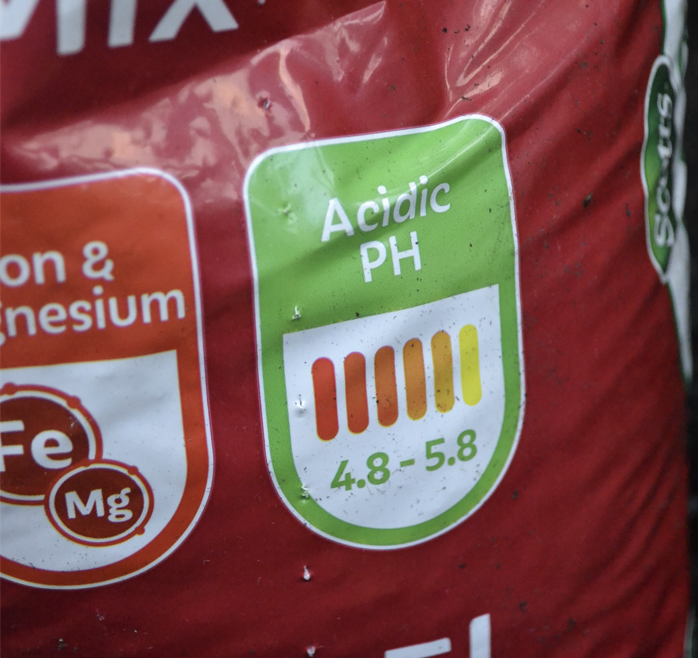
- Option 2: Harder option requiring maths skills and patience. If you don’t have access to a low pH potting mix formulation, you can also use elemental sulphur. You can buy this in a powered form in a packet and you mix it into soil according to the packet instructions (you will need to do some calculations to figure out the volume of your soil and measure out the right volume with the spoon provided). However, be warned that sulphur acts slowly and is not for the impatient gardener. In our experience it takes at 2 months before the pH is lowered. You will need to test again prior to planting your blueberry into the soil to check that you have done your maths correctly. With this method you will need to be plan in advance and be organised, it’s not as simple as planting straight in.
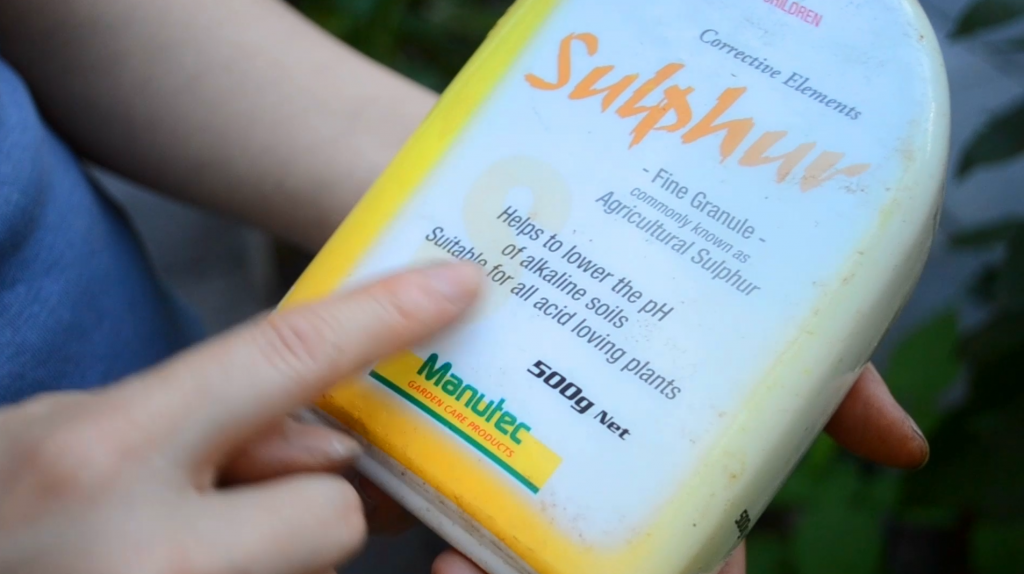
+ Add compost/ Regardless of which option you go with, I’d recommend also adding some home-made compost which is generally slightly acidic or pH neutral (don’t add lime to your compost!) to bulk out your mix and increase moisture-holding capacity. Starting with the right potting mix is vital and then follow my golden rule #7 to maintain the acidity of your soil over the years.
Quick Blueberry FAQ
Why does my blueberry have veins on its leaves? Look at the difference between our blueberry grown on the left in a standard high pH potting mix vs on the right the glossy green leaves of a blueberry in a proper low pH potting mix.
- If the pH isn’t right, you will see veining on the leaves of your blueberry leaves, or very pale leaves, both of which suggest a nutrient deficiency. You might think your plant is starved of nutrients and needs a feed, but this is actually because the blueberry plant can’t uptake nutrients at a higher pH – not necessarily because of a deficiency in something.
- You need to get it out of that potting mix and into a new mix and your blueberry plant will return to a glossy green again. Check out our experiment in our video workshop above, to see the effects of growing blueberries in the wrong pH.
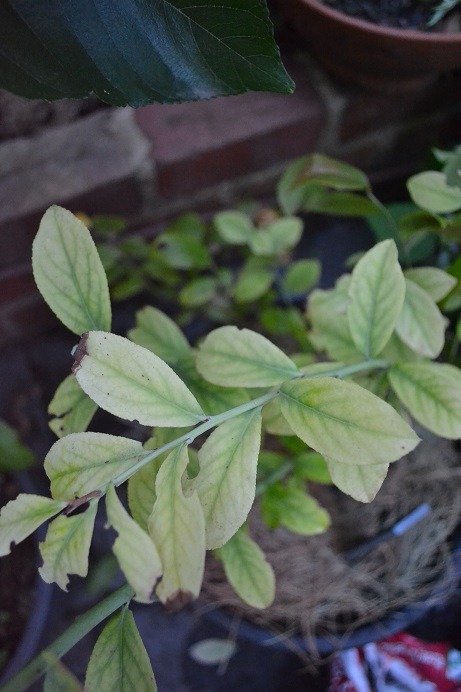
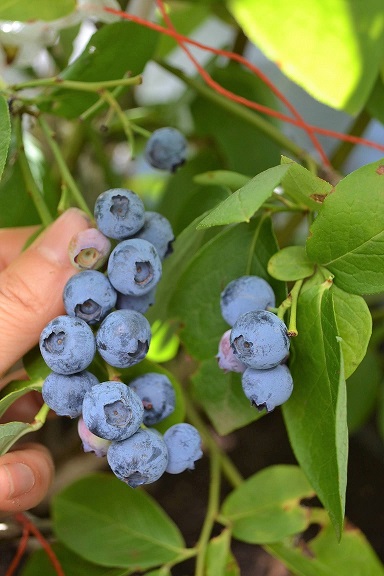
Should I add peat moss? You’ll hear lots of suggestions to use peat moss for your blueberries. The short answer is No, you don’t need it. The harvesting of peat moss is quite destructive to the environment and ecosystems. Peat bogs store a third of the world’s soil carbon. Harvesting and using peat moss releases carbon dioxide contributing to release of greenhouse gases. Not to mention it comes in small bags and is expensive to buy. With a good potting mix and my tips for soil improvement below, you won’t need any fancy additives. Your wallet and the environment will thank you for it.
Golden Rule 2: Blueberries are best grown in pots or containers
Because blueberries are fussy about having an acidic soil, it’s easier to grow blueberries in a large pot or wine barrel, or if you want to get serious, in a dedicated bed filled with blueberries. This way, you can create the ideal acidic conditions that they thrive in. Not many other fruiting or edible plants in our garden need these acidic conditions, hence it’s better to quarantine your blueberries. Blueberries are shallow rooted plants so grow well in pots. Choose a pot that’s at least 30cm wide and 30cm tall.
Do not however plant them with cane berries!! They will just take over. Check out our video workshop above for more information on this disaster from last season, and how we quickly fixed the problem.
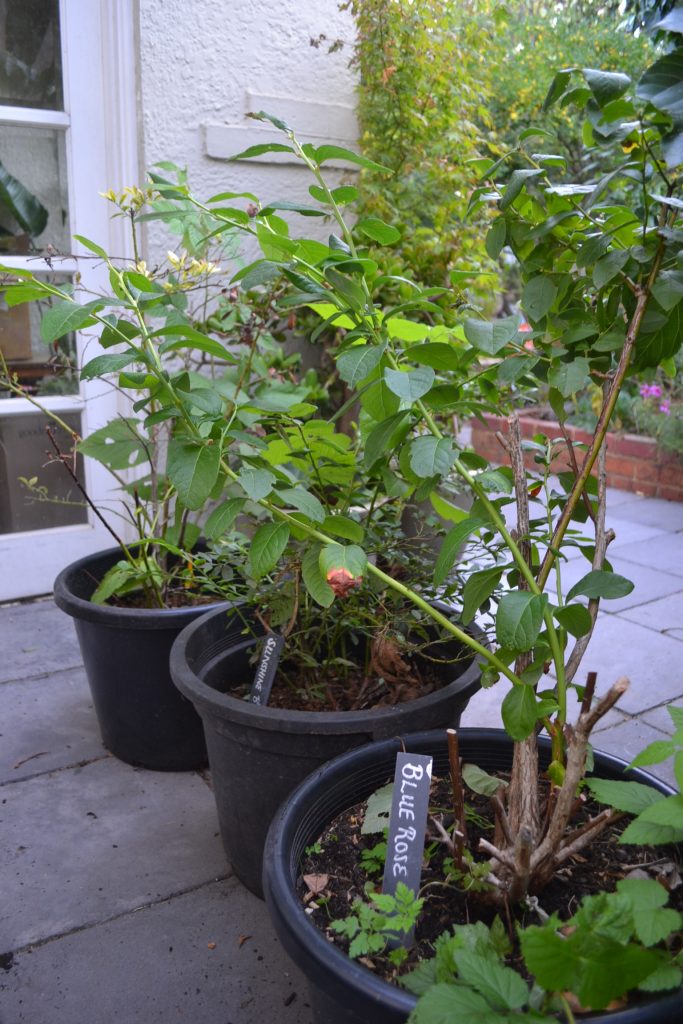
Golden Rule 3: Grow blueberries in part-shade
Blueberries originate from the forests of North America and were found under pine and oak trees. Hence they enjoy some dappled light, and protection from the brutal western afternoon sun. Planting blueberries in a full sun spot in summer will turn their leaves crispy. So find a spot with gentle morning sun but sheltered from the harsh afternoon sun.
A benefit of growing blueberries in pots is that in winter, they go dormant and you can simply move your blueberry pots to a shady spot thereby vacating any full-sun winter spot for your winter veggies! Clever gardening in action.
Golden Rule 4: Blueberries love moist soil
In their native conditions in the lower canopy in forests, blueberries enjoyed moist feet. BUT be careful moist soil is not the same as wet water-logged soil. They still need good drainage. So getting your starting mix right with a quality potting mix in Golden rule #1 is vital. Adding in compost for extra water holding capacity will reduce how often you need to water. In summer you will need to water every day or second day, to ensure that your blueberry always has moist roots. If you enjoy a summer holiday, install a drip irrigation system for your pots to ensure your blueberry doesn’t dry out.
Blueberries go dormant over the cooler winter season. We don’t water ours at all during this time as we have a cold wet winter. If you are in a climate with a dry winter, you should check on them by sticking your finger into the soil down to the first knuckle, if dry give it a water.
Golden Rule 5: Mulch is essential
Being shallow rooted, you need to mulch heavily to prevent your blueberries roots drying out. Mulch also protects your soil structure and the life within your soil, and reduces evaporation of water from the soil, so is a non negotiable. Our favourite mulch for blueberries is pine needles – they are mildly acidic but note that once they decompose they are pH neutral – we love them as they’re widely available in our area via Christmas trees thrown out each January.
Blueberries naturally lived in North American pine forests (both enjoy similar acidic conditions). I think they always look more at home surrounded by a layer of fluffy pine mulch. You can also use another sustainable source of mulch, autumn leaves or even coffee grounds [read our article here on the right way to use coffee grounds]. And if you must, the plastic packaged mulches like sugar cane or pea straw will also do, but always look for a local and sustainable source first.
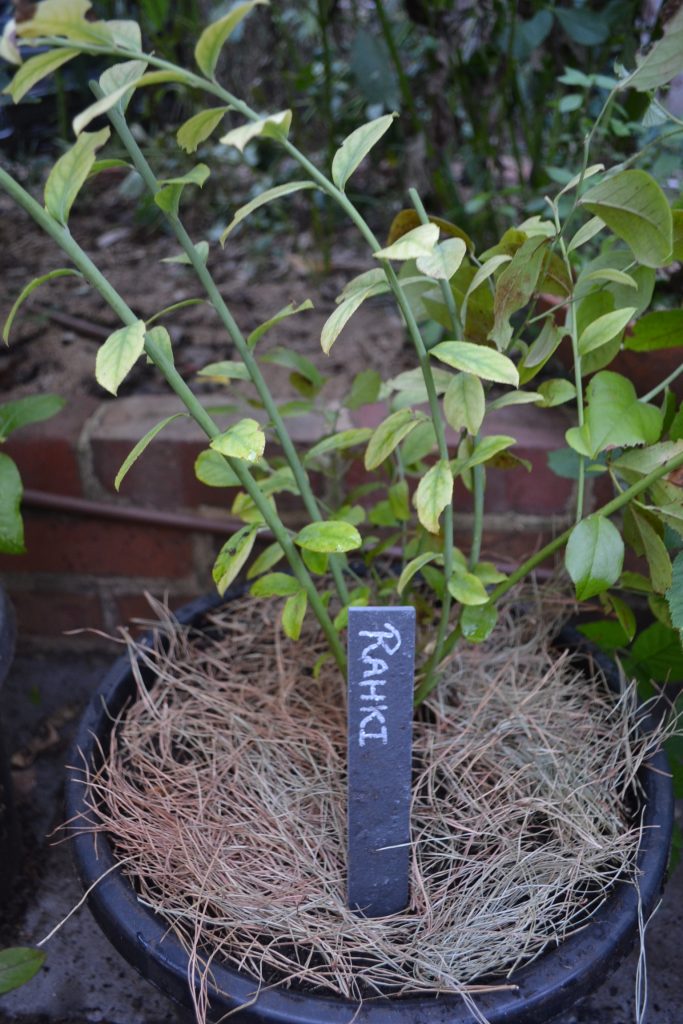
Golden Rule 6: Grow more than one variety for cross-pollination
For bigger, tastier berries grow more than one variety of blueberry. When bees cross-pollinate them, you get better fruit. Who doesn’t want plumper tastier berries? It’s also pretty hard to just stop at one plant as they are so delicious. This is one of the reasons we have 7 plants: we grow two Sunshine Blue Blueberries (a compact, low chill variety great for beginners), Blue Rose (a blueberry with big leaves and berries, with dramatic autumn colours), and four varieties new to us last year: Nui, Rakhi, Reka and Maru. They’re so compact why not squeeze a few more in for bigger and more berries!
Golden Rule 7: Soil improvement
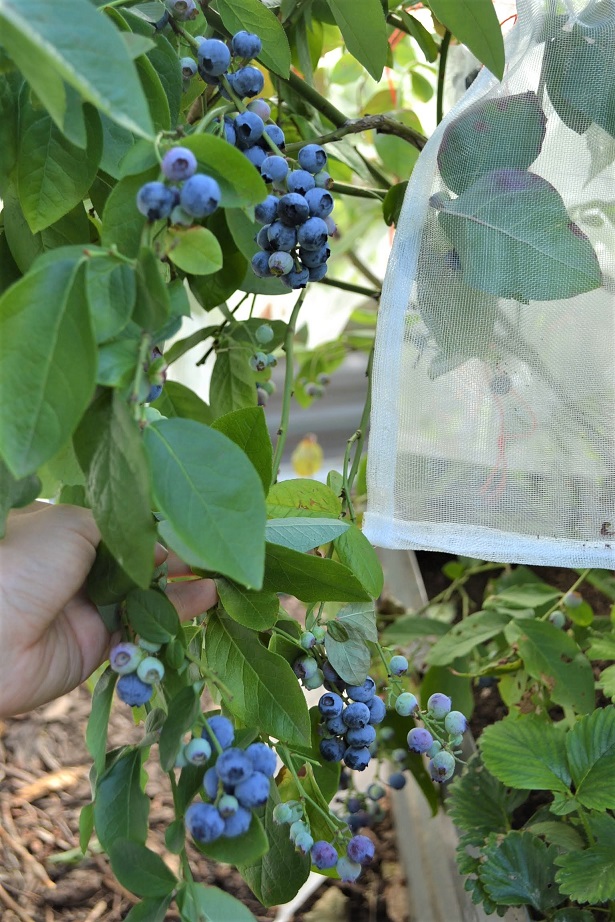
Just as you need to constantly improve and work on your soil every season, the same goes for your potted blueberries. You should be topping up with compost and manure each season. Blueberries are best fertilised in late/winter early spring, just after flowering to give them a boost to lots of big berries. If you notice veining or pale leaves, you will likely need to lower the acidity of your soil. We find that our soil pH tends to creep up over time. There are a few ways to lower your soil pH:
- In late autumn or winter when your plant is dormant, you can repot your blueberry with fresh potting mix. We again recommend Osmocote Roses, Gardenia & Azalea potting mix, for an easy no-fuss solution. It’s best to repot your blueberry every 3 years. If you notice your soil levels have dropped, you can simply top up with more potting mix as required.
- Do a pH test of your soil, and add elemental sulphur according to packet instructions to adjust back down into the 4.5-5.5 zone.
- Secret tip: Throughout the year, when you eat citrus such as oranges, mandarins or lemons, throw the peels around your blueberries. Not only will these act as a mulch, but when they break down, they will add valuable organic matter to your soil. They are also mildly acidic and are a gentle way to help maintain a lower soil pH.
What about coffee grounds? You’ll hear all sorts of advice that coffee grounds are acidic and are great for your blueberries. Read my myth-busting article here to understand how they really work. The same goes for pine needles. While you can add coffee grounds and pine needles, they are actually pH neutral when they break down. They are not acidic contrary to popular belief. They will add valuable organic matter, but you cannot rely on them alone to keep your soil in the right pH range.
Stay tuned for the next edition where we talk about how to net your blueberries for an epic harvest, compare our varieties, look at the lifecycle of blueberries and how to know when your blueberries are ripe for picking! Don’t forget to check out our growing guide for raspberries, mulberries, youngberries, currants and much more!
Great info. Will you be doing an article on how to prune blueberries? I’ve watched videos but still got it wrong. I think I over-pruned last year and barely got any berries this year 🙁
Fantastic information, I have had no luck with blueberries! Want to be successful in growing them.
Have put three different varieties of blueberries in pots with the potting mix that’s recommended, fingers crossed.
I have 7 plants in raised beds that are quite successful your growing tips are spot on
Thank you. So much valuable information. So glad I lucked onto this site.
Thank you so much for a very informative and helpful article. You have given me the confidence to start growing my own blueberries
Thank you for making your instructions so easy for the home gardener. I’m in SE QLD so potted a Berrylicious yesterday. Do you recommend any other varieties please? Do you need more than one Blueberry to propagate? Keep your soil health tutorials coming. So helpful. Much appreciated ❤️👌
Hi I love your videos. For the past 2 years I have not been able to grow blueberries as i did not know the soil had to be acidic. Today after your article I went to Bunnings and bought 2 tubs of Sunshine Blue as there were no other varieties.
Where can I buy the other varieties you suggested? Most places either out of stock or very expensive.
I might try growing other berries. Currently I have a blackberry bush that grew from nowhere in my backyard and only 2 months ago I realised I was doing the wrong things with my blackberry. However thanks to youtube and helpful people like you, I think I have managed to trellis and prune the canes.
You videos are really detailed and very helpful.